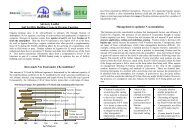A review of leguminous fertility-building crops, with particular ...
A review of leguminous fertility-building crops, with particular ...
A review of leguminous fertility-building crops, with particular ...
You also want an ePaper? Increase the reach of your titles
YUMPU automatically turns print PDFs into web optimized ePapers that Google loves.
A <strong>review</strong> <strong>of</strong> <strong>leguminous</strong> <strong>fertility</strong>-<strong>building</strong> <strong>crops</strong>, Defra project OF0316 Executive Summary<br />
later years. Nitrogen transfer can occur through root excretion and decomposition, leaching<br />
from leaves and in leaf-fall and animal excreta.<br />
Estimates <strong>of</strong> N fixation by white clover span a wide range <strong>of</strong> values and in spite <strong>of</strong> the<br />
abundant information, there is still uncertainty about the quantities fixed. Much <strong>of</strong> the<br />
variation in N-fixation can be attributed to differences in the proportion <strong>of</strong> clover in mixed<br />
swards. Almost all studies indicate that white clover obtains most <strong>of</strong> its N from the<br />
atmosphere rather than from the soil. There is evidence that the proportion <strong>of</strong> N derived from<br />
the atmosphere (%Ndfa) is less under grazing than where swards are mown.<br />
Red clover may be more productive than white clover. As <strong>with</strong> white clover, a high<br />
proportion <strong>of</strong> N in red clover is obtained by fixation. Also, as <strong>with</strong> white clover, there is<br />
evidence <strong>of</strong> differences in the quantity <strong>of</strong> N fixed by different cultivars.<br />
Data for subteranean clover are fewer, reflecting that it is not a common UK crop.<br />
However, N fixation appears to be affected in a similar way as <strong>with</strong> white and red clover.<br />
The crop obtains most <strong>of</strong> its N from fixation, and fixation is greater under a cutting than a<br />
grazing regime.<br />
Lucerne is more persistent than red clover and has a productive life <strong>of</strong> up to 4 years. Yield is<br />
little affected by drought during British summers. Constraints on growth are poor drainage<br />
and very acid subsoils. It is therefore restricted to deep, free-draining, calcareous soils. As<br />
<strong>with</strong> the other legumes <strong>review</strong>ed, there is a wide range <strong>of</strong> N fixation values. Lucerne seems<br />
<strong>particular</strong>ly susceptible to soil nutritional status, and inoculation is essential.<br />
There is little information about the quantities <strong>of</strong> N fixed under UK conditions by trefoil and<br />
by sainfoin. There is an indication that sanfoin is less effective at fixing N than red clover.<br />
Peas and beans tend to be grown as a <strong>fertility</strong> boost, part way through the arable phase <strong>of</strong> a<br />
rotation. N fixation varies, partly depending on the amount <strong>of</strong> soil mineral N present.<br />
Generally, the proportion <strong>of</strong> the crop’s N derived from fixation is smaller than from red or<br />
white clover. A large proportion <strong>of</strong> the fixed N is removed from the field in harvested seed,<br />
though the haulm, roots and rhizodeposits usually provide a positive N balance to the soil.<br />
Net benefits <strong>of</strong> soybeans to following <strong>crops</strong> are also generally small because <strong>of</strong> the removal<br />
<strong>of</strong> N in harvested grain.<br />
Factors that limit plant growth normally also limit fixation, either through direct effects on<br />
nodule formation or function or indirectly through the host plant's ability to supply nutrients.<br />
However, some forms <strong>of</strong> stress (e.g. excess soil water, drought, cold or heat) have a greater<br />
effect on nodule function than on nitrate uptake so that plants relying on fixation may be<br />
more severely affected than plants supplied <strong>with</strong> fertiliser-N. In these situations,<br />
improvements in general growing conditions would be expected to benefit N-fixing plants<br />
more than those relying on fertiliser. Fixation can also be affected by soil structure and by<br />
disease. Where inoculation is used to introduce more effective rhizobia, the response will be<br />
influenced by the effectiveness <strong>of</strong> the native rhizobia and their competitive ability.<br />
Effectiveness can also be reduced, e.g. in soybean, where there is a temporal separation<br />
between maximum nitrate assimilation and N-fixation activity.<br />
Regional differences and year-to-year fluctuations in weather patterns will influence legume<br />
growth and fixation activity through effects <strong>of</strong> temperature, moisture supply and radiation.<br />
Written by S Cuttle, M Shepherd & G Goodlass Page 4




